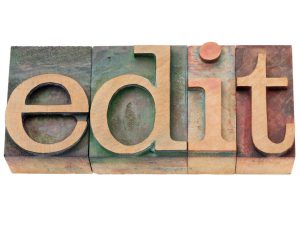
Developmental editing (structural), line editing, copyediting and proofreading are all distinct and equally important stages of the editing process. Each phase focuses on a different aspect of the text, but each plays an important part in bringing a manuscript to a publishable standard.
Some editors, like AJC Publishing editors, combine copyediting and line editing as one process, as there is often some overlap. Developmental editing, however, needs to be done as a separate phase as there might be a fair amount of rewriting required, which would make copy or line editing a waste of time for both the editor and author. Proofreading, of course, is the final step before publication.
Because each editor has their own style of working and may have a different interpretation of what each editing task involves, it’s always a good idea to ask them to be clear on exactly what their service will be providing.
I have provided here a sample of each type of service so you can visualise what each looks like.
I suggest you always hire an editor who is registered with a professional editing body to ensure they are qualified to provide the service they are offering.
Developmental editing
Developmental editing (also known as structural editing) involves looking at the big picture of the manuscript. This includes assessing the overall structure, organisation of scenes, pacing, and coherence of the manuscript. This may mean rearranging chapters or sections, removing or suggesting added content, and revising the narrative arc and character development. The goal of structural editing is to ensure that the manuscript is engaging, compelling and makes sense as a whole.
Sample
The following is a sample of a developmental edit. Note that the edit mainly takes the form of commenting on the document rather than editing the text itself, although some editors may restructure paragraphs or chapters. It also includes a comprehensive editorial report. Also keep in mind that this is only a one-page sample, whereas a full developmental edit casts a much broader net than the few character and plot issues I have pointed out here.
Line Editing
Line editing focuses on the style and structure of the text, rather than the story. A line editor will review the manuscript line by line, looking for ways to improve the writing by adjusting the phrasing, sentence structure and tone. They will pay close attention to the author’s voice and make suggestions to enhance it, while also ensuring that the text is engaging and easy to read.
Sample
The following is a sample of a line edit. Note there can be some overlap between copyediting and line editing, which is why our editors do both processes at the same time.
Copyediting
Copyediting focuses on ensuring a manuscript reads smoothly and is free of errors and inconsistencies in grammar, punctuation, spelling, and formatting. Copyeditors may also suggest changes to the text to improve clarity, coherence and readability
Sample
The following is a sample of a copyedit. Note that the commenting on this sample is quite prolific to explain each change. However, in the real world, copyeditors will generally explain issues once or twice, then move to either simply correcting the issue (if it’s a simple fix) or leave a comment directing the author to fix the issue themselves.
Proofreading
Proofreading is the final stage of catching any last-minute errors missed by a copyeditor or introduced during the design phase before a manuscript goes to print. Often confused with copyediting, it serves a different purpose – a proofreader isn’t looking to correct language, flow or story issues. They are your last Hail Mary before a book goes to print.
In the past, a proofread was completed on what publishers call a “proof” – a PDF typeset version of the manuscript provided by a designer, and only egregious errors would be pointed out, along with formatting issues. Traditional publishers still work this way.
However, with the explosion of the indie self-publishing market, proofreaders now often perform the proofread on a Word document, which the author will then either convert to book form via readily available online software, such as Vellum (Mac), Atticus (Windows) or Calibre (Windows and Mac), or upload straight to platforms such as Amazon or Draft2Digital, which can perform the conversion for you.
Sample
The following is a sample of a proofread. If the proofreader is working on a pdf file, they won’t correct the text itself but will leave comments for the designer to address. If the proofreader is working on a Word document, they will use Track Changes, only commenting where the correction is not clear. Since proofreading is completed after the copyediting phase (or design phase if a commercial publisher) there should only be minimal corrections required.
Summary:
- Developmental editing focuses on the big picture: story, character, scene, pace and coherence.
- Line editing focuses on style, sentence structure, meaning and flow.
- Copyediting focuses on grammar, punctuation, spelling, and formatting.
- Proofreading catches any remaining errors and formatting issues.
Each type of editing is important for ensuring that a manuscript is well-written and relatively error-free before moving onto proofreading and submitting to publishers or self-publishing.